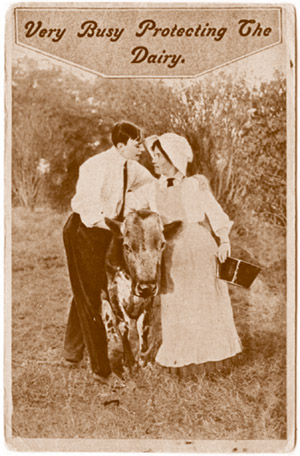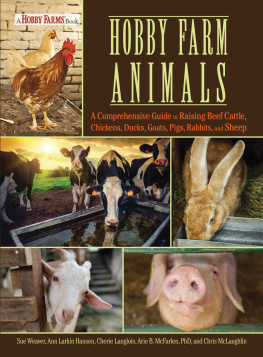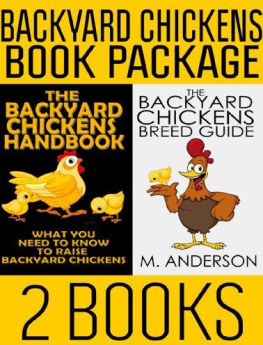The
BACKYARD
COW
An Introductory Guide to
Keeping Productive Pet Cows
Sue Weaver

The mission of Storey Publishing is to serve our customers by
publishing practical information that encourages
personal independence in harmony with the environment.
Edited by Sarah Guare and Deborah Burns
Art direction and book design by Cynthia N. McFarland
Text production by Liseann Karandisecky
Photography by Jason Houston: cover (except for author photo), 123, 129 (bottom left), 136 (top left), and 137; Lynn Stone: 124128 and 129 (top right & left, bottom right), 130135 and 136 (top right, bottom); Marcelino Vilaubi: 138, and John Weaver: author photo, back cover
Antique photographs and ephemera provided by the author.
Cover lettering by Jim Datz
Illustrations by Elayne Sears, except by Elara Tanguy: 155, 175, 197, 200 (right), and (left, bottom right)
Indexed by Christine R. Lindemer, Boston Road Communications
A special thank you to Blue Hill Farm, Great Barrington, Massachusetts; models Sean Stanton and Sophia Hermann; and cover cows Dame (Dutch Belted) and Annabelle (Normande)
2012 by Sue Ann Weaver
All rights reserved. No part of this book may be reproduced without written permission from the publisher, except by a reviewer who may quote brief passages or reproduce illustrations in a review with appropriate credits; nor may any part of this book be reproduced, stored in a retrieval system, or transmitted in any form or by any means electronic, mechanical, photocopying, recording, or other without written permission from the publisher.
The information in this book is true and complete to the best of our knowledge. All recommendations are made without guarantee on the part of the author or Storey Publishing. The author and publisher disclaim any liability in connection with the use of this information.
Storey books are available for special premium and promotional uses and for customized editions. For further information, please call 1-800-793-9396.
Storey Publishing
210 MASS MoCA Way
North Adams, MA 01247
www.storey.com
Printed in the United States by Versa Press
10 9 8 7 6 5 4 3 2 1
LIBRARY OF CONGRESS CATALOGING-IN-PUBLICATION DATA
Weaver, Sue.
The backyard cow / by Sue Weaver.
p. cm.
Includes index.
ISBN 978-1-60342-997-9 (pbk. : alk. paper)
1. Dairy cattle. I. Title.
SF208.W39 2012
636.2142dc23
2011049412
This book is dedicated to the fantastic people at Storey Publishing
who work with me to create these books,
especially Deb Burns, Sarah Guare, Cindy McFarland,
Mars Vilaubi, and Jessica Richard,
and to Elayne Sears, who illustrates them so beautifully.

Contents
Preface
When I was a little girl, most evenings I would sit cross-legged by the road waiting for the evening cow parade. That was when our neighbor, the younger of two dairy-farming bachelor brothers, drove his cattle home. Hed wave and Id wave and that was that until the night he let me ride pretty Bonnie.
Bonnie was a doe-eyed, rusty brown Jersey with a bell around her neck. She was old and gentle to a fault. As she plodded along the well-worn cow path that paralleled the road, I felt like a princess on a pretty palfrey.
After that I often waited at the road with cookies: two for Mr. Engle and one for my new friend Bonnie, and from time to time he let me ride her. That was when the madness began. I still lived and breathed horses (my childhood passion), but I wanted a cow to ride too. That desire didnt diminish through the years, and 55 years later I achieved my goal. Now Im raising my very own riding and driving steers.
What I learned when I bought my first steer is this: Almost everything written about cattle addresses cattle in herds, not the house cow kept to furnish families with homegrown dairy products, nor a steer or two for riding and driving. This is the book I wish I had had when I first started. It is for those people who want to keep cattle on a small scale, be it for household dairy or recreational purposes (or both), and who also want to know a bit of the history and folklore surrounding their new bovine friends.
So lets get moooving. Bring on the cows!
Part One
Meet the Cow


Brief History
May cows stay in front of me,
May cows stay behind me,
May cows stay on both sides of me,
May I always reside in the midst of cows.
Sanatana Goswami and Gopala Bhatta Goswami,
Hari Bhakti Vilasa, 16.252
C attle have provided humans with meat, milk, draft power, and leather for upwards of 10,000 years. Their tallow fueled oil lamps and was used to make candles, necessities of ancient (and not so ancient) life. Cattle furnished dung to nourish the earth; dried, it served as cooking and heating fuel where none other existed. Artisans used cow horn to fashion utilitarian items like spoons, powder horns, and flagons, but also to craft musical instruments as well as exquisite works of art. Bones were used to create amulets, pendants, and beads. Wealth was frequently reckoned in cattle, and cattle paid for many a herdsmans bride. Cattle have been used for religious sacrifices for many thousands of years, yet they were (and still are) sacred to people of many faiths.
The story of mankinds love affair with the bovine tribe is a rich feast to be savored, so rather than serve it up in a single, sumptuous meal, weve scattered it throughout this book in tantalizing tidbits. Watch for them as this tale unwinds.
First Came the Aurochs
In the beginning was the aurochs, an immense wild bovine whose name means primeval ox. More than one million years ago, the aurochs spread from its original home in Pakistan and India to the far corners of Asia, Europe, and Africa, surviving when other prehistoric mammals of its ilk became extinct.
Compared to modern cattle, aurochs were long-legged, front-heavy, and enormous. Based on bone measurements, the average European aurochs bull weighed 2,000 pounds (910 kg) and stood 17 hands tall at his massive shoulders; thats almost 6 feet (1.8 m) one really big cow. Females were smaller. Both sexes had graceful, lyre-shaped horns, each up to 3 feet (just under 1 m) in length, that tipped forward in the style of Spanish fighting bulls. From ancient cave paintings, the most famous being the Lascaux cave paintings in southern France, we know that European aurochs bulls were generally sooty black with a cream-colored dorsal stripe; cows and calves of both sexes were reddish brown. All had cream-colored areas encircling their muzzles.
Paleontologists believe the aurochs reached Europe as early as 250,000 bce. Eventually, their range extended north through the British Isles to southern Scandinavia, then east through Europe and north to Siberia. They roamed North Africa, the Middle East, Pakistan, India, and Central Asia too. They were, however, gradually hunted to extinction until the seventeenth century, when the last herd of aurochs remained in a royal game preserve in Poland. Despite royal efforts to conserve them (killing one was punishable by death), the last living aurochs, a cow, was killed by poachers in 1627. Thus ended the reign of the largest cattle ever known to walk this earth.








 Brief History
Brief History